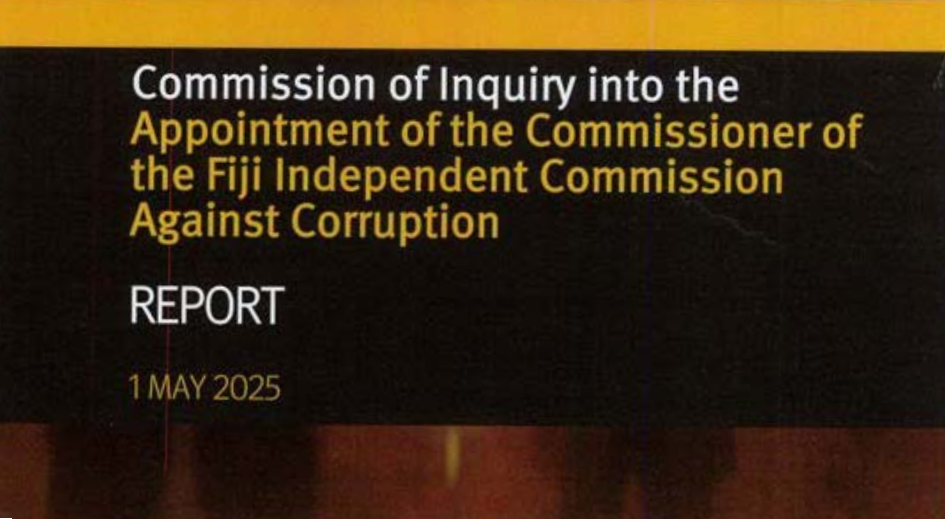For more than a week, excerpts of a 682-page document have been circulating on social media. All the pages bear the footer “Commission of Inquiry into the Appointment of the Commissioner of FICAC”.
So, is this the real version of the report of the Commission of Inquiry into the appointment of Fiji Independent Commission Against Corruption Commissioner Barbara Malimali in September last year?
Counsel assisting the COI, New Zealand lawyer Janet Mason, confirmed to The Fiji Times earlier this week that the document looked like the final version of the report submitted to President Ratu Naiqama Lalabalavu.
She has expressed disappointment at the leak.
There have been mixed public reactions to the report. Some political parties and commentators have described it as exposing weaknesses in Fiji’s legal institutions.
Others have attacked the credibility and the independence of the commissioner, Supreme Court judge Justice David Ashton-Lewis.
One social media commentator has questioned why there appears to be two different copies of Justice Ashton-Lewis’s “letter of transmittal” of his report to the President.
Earlier this month Justice Ashton-Lewis gave a controversial interview to an Australian radio station about his involvement in the inquiry, in which he said he had carried out the inquiry to help Prime Minister Sitiveni Rabuka find “the crocodiles in the pond.”
Who leaked it?
Before the documents surfaced, video footage from the “closed-door” inquiry was already circulating on social media. These clips included key witnesses giving evidence during the inquiry. They showed senior government and judicial officers being questioned about various aspects relating to Ms Malimali’s appointment and her tenure as commissioner.
The first part of the report to leak was its alleged ‘executive summary’ page, which named several high-profile individuals allegedly implicated in irregularities found in Ms Malimali’s appointment.
In the days that followed, additional documents, alleged to be chapters from the much-awaited report appeared online, drawing intense scrutiny from government critics and social media activists.
So, who leaked it?
According to Ms Mason, the alleged report must have been leaked by someone “who had a hard spiral bound copy of the report”.
The leaked copy seems to have been photographed or scanned from the unredacted version of the report, copies of which, Ms Mason said, were only accessible to a few individuals.
On May 1, the Prime Minister is alleged to have received the report from the CoI, and on May 21, he confirmed that he had read the report and was preparing to meet the President.
He met Ratu Naiqama on the afternoon of May 22 where they discussed the report and its contents, and whether to have it published or not.
On June 5, Mr Rabuka met with Commissioner of Police Rusiate Tudravu and Republic of Fiji Military Forces (RFMF) commander Ro Jone Kalouniwai where he gave them copies of the report.
A copy was also given to FICAC and to the Solicitor-General, as confirmed by Mr Rabuka.
What is the report’s impact?
The leaked documents allegedly implicate a wide range of high-ranking individuals including in FICAC, the Cabinet and the Judiciary and the judicial administration. A number of senior lawyers are alleged to have interfered with a controversial attempt by FICAC acting deputy commissioner Frances Puleiwai to arrest Ms Malimali on the day she took office.
The report recommends that a number of these individuals be investigated for possible offences ranging from fraud, forgery, witness tampering, false representation, perjury, perverting the course of justice, abuse of office, obstruction of justice, conspiracy, and obstruction.
Two high-profile figures have already fallen from their positions – Ms Malimali herself, who was first suspended by the President and then dismissed, and former attorney-general Graham Leung, who was abruptly dismissed by the PM soon after receiving the report.
Ms Malimali has issued legal proceedings challenging her dismissal, saying the President did not have the power to do what he did.
One interesting aspect of the report’s release was the interest expressed in the report by Republic of Fiji Military Forces (RFMF) commander Ro Jone Kalouniwai, who has not commented publicly since his meeting with the Prime Minister.
We have been reliably informed that Mr Kalouniwai has been advised to limit his interactions with the media, but the involvement of the RFMF itself, and the fact that they’ve been given a copy of the report, highlights the seriousness of the report’s findings.
What now?
What now? Some may ask.
With Ms Mason confirming to the media that the circulated documents “does look like the final version which the CoI submitted”, will this mean that we will finally be seeing a full, unredacted, government-published CoI report in the coming days? Possibly this week?
Only time will tell.
And will there be any investigation into how the documents got leaked? Or will any of the allegedly named individuals file a police complaint asking for the leak to be investigated?
On this, too, only time will tell as well.
For now, everybody — including social media activists, the political opposition and even those implicated in the report — are calling for it to be released. Those implicated say it is unfair for them not to have an official copy of the document that they cannot legally challenge.
So far, the Prime Minister has given no definite date for the report’s release.
Interesting times ahead.



